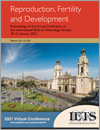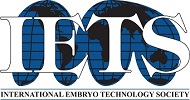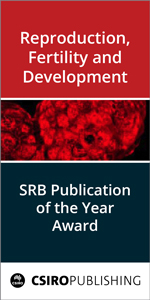
Reproduction, Fertility and Development
Volume 33 Numbers 1 & 2 2021
Special IssueProceedings of the Virtual Conference of the International Embryo Technology Society, 18–21 January 2021
Full Papers and Abstracts for Poster Presentation
RDv33n2refsIETS 2021 Section Editors and Manuscript and Abstract Reviewers
RD20205Key traits for ruminant livestock across diverse production systems in the context of climate change: perspectives from a global platform of research farms
What do we need from our livestock and what traits do they require in a climate-changed world? There are diverse livestock production circumstances around the globe, and the approaches for selecting ruminant livestock for food security must encompass future climate conditions and the genetic and feeding resources of each system. We have identified and prioritised relevant traits for dairy cattle, beef cattle and sheep from a global network of research farms covering diverse agroclimatic conditions that can orientate breeding strategies.
RD20205 Abstract | RD20205 Full Text | RD20205PDF (789 KB) | RD20205Supplementary Material (486 KB) Open Access Article
RD20257Investigation of male and female infertility in llamas and alpacas
Diagnosis of the causes of infertility in llamas and alpacas can be tedious and requires a thorough clinical examination of the animal. This article describes the approach used by the authors to investigate causes of infertility. A review of clinical cases shows that these species have a high rate of reproductive congenital abnormalities. Other major causes of infertility include trauma, infections and birthing complications. Prebreeding reproductive evaluation is important for maximising fertility and maintaining the good health and well-being of the animal.
RD20206In vitro production of small ruminant embryos: latest improvements and further research
The in vitro production of embryos is an extremely important tool for the genetic improvement for livestock. In this review, the main obstacles to and improvements in this biotechnology in goats and sheep are presented. A recent outlook indicates that if only the blastocyst rate is considered, the overall efficiency achieved in recent studies is similar to that obtained two to three decades ago; however, the quality of embryos is increasing, and cryotolerance is extremely important for the industry.
As the international production and trade of embryos continues to grow, it is imperative to continue to evaluate emerging and re-emerging embryo pathogens. This paper highlights the growth of in vitro-produced embryo production internationally and the emerging and re-emerging pathogens that are of concern to the international trade of embryos. There are some pathogens that are of special concern because they have been shown to be associated with the embryo and pose a potential threat to the international trade of embryos.
RD20213Heat stress reduces maturation and developmental capacity in bovine oocytes
The ovarian pool of follicles, and their enclosed oocytes, is highly sensitive to hyperthermia. This review discusses some cellular and molecular mechanisms by which heat stress compromises oocyte developmental competence, emphasising that even though the oocyte is exposed to heat stress, changes are also manifested in the developed embryo. The effect of heat stress carries over from the summer to the autumn, but there is a spontaneous recovery until the winter, indicating that the phenomenon is transient.
RD20256Embryonic diapause in mammals and dormancy in embryonic stem cells with the European roe deer as experimental model
Embryonic diapause, the suspension of embryo development before implantation, was first described over 150 years ago in the European roe deer. Its regulatory mechanisms in the roe deer remain unknown to date. This review advances the current understanding of the regulation of diapause by highlighting the effect of hormones and the cellular microenvironment on diapausing embryos and dormancy in embryonic stem cells. The roe deer is established as model organism to study cell proliferation and extending pluripotency.
RD20256 Abstract | RD20256 Full Text | RD20256PDF (226 KB) Open Access Article
RD20264Dry storage of mammalian spermatozoa and cells: state-of-the-art and possible future directions
Our work has demonstrated that using a mild, −0°C temperature prior to water sublimation results in better preservation of DNA integrity of freeze-dried ram spermatozoa, resulting in turn in improved embryonic development once used for fertilisation through ICSI.
RD20264 Abstract | RD20264 Full Text | RD20264PDF (518 KB) Open Access Article
RD20265Artificially produced gametes in mice, humans and other species
The production of spermatozoa and eggs from pluripotent stem cells in a culture dish is a key challenge in reproductive biology and regenerative medicine. It has been achieved in mice, but not yet in humans and other mammals. This review updates the frontline of gamete production in culture and discusses the benefits of and issues with the technology.
RD20255Environmental impacts on sperm and oocyte epigenetics affect embryo cell epigenetics and transcription to promote the epigenetic inheritance of pathology and phenotypic variation
Previous studies have demonstrated that exposure to environmental factors can cause epigenetic modifications to germ cells, particularly sperm, to promote epigenetic and transcriptome changes in the embryo. The studies reviewed in this paper support the idea that environmentally induced epigenetic changes in germ cells affect alterations in embryo cell epigenetics and transcriptomes that have an important role in the epigenetic inheritance of pathology and phenotypic change.




